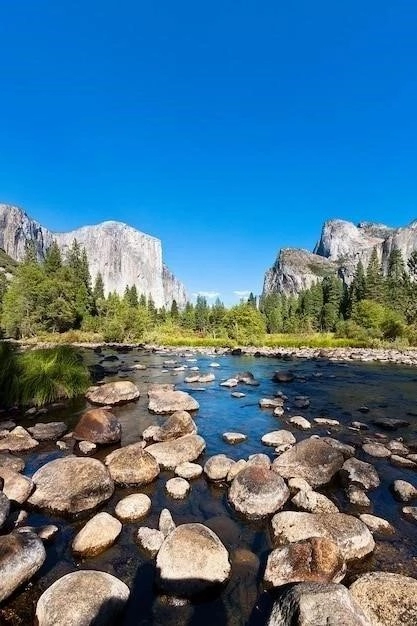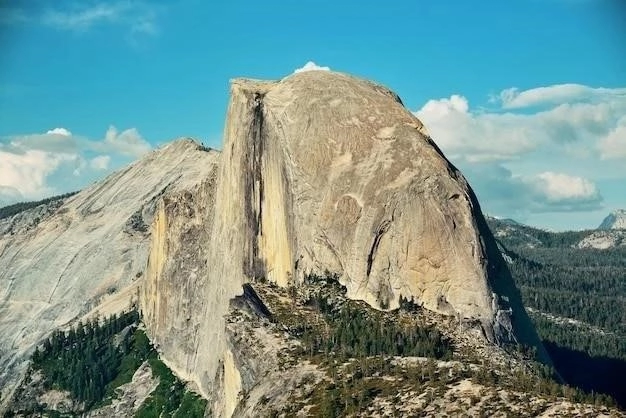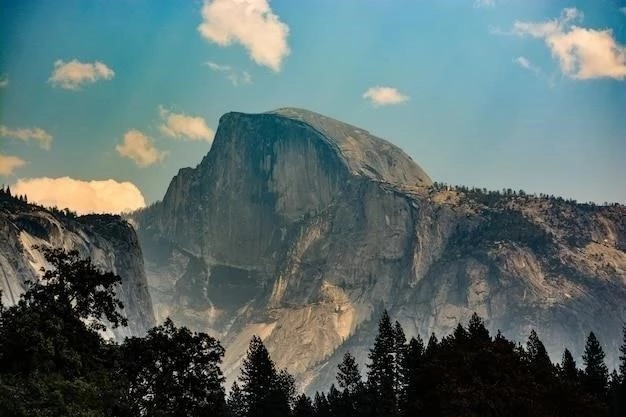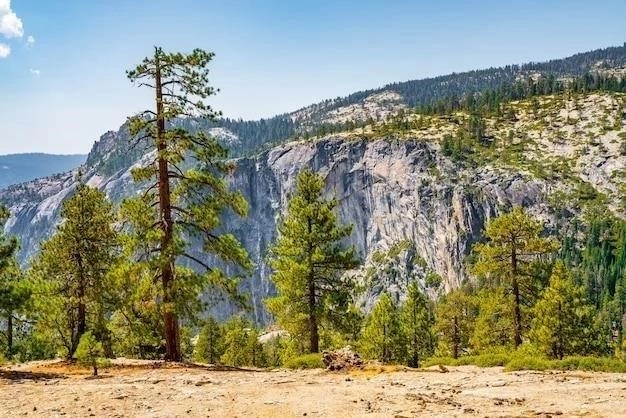Nestled in the heart of the Sierra Nevada mountains of California, Yosemite Valley stands as a testament to the awe-inspiring power of nature. This iconic valley, carved by glaciers over millennia, is renowned for its towering granite cliffs, cascading waterfalls, and serene meadows. Designated as a World Heritage Site in 1984, Yosemite Valley attracts millions of visitors each year, drawn to its unparalleled beauty and recreational opportunities.

Geological History
The geological history of Yosemite Valley spans millions of years, a captivating narrative told through its granite cliffs and sculpted landscapes. The story begins with the formation of the Sierra Nevada range, a process driven by the collision of tectonic plates. Over time, molten rock, or magma, rose from deep within the Earths crust and slowly cooled to form the granite that characterizes the region.
Uplift and Erosion
As the Sierra Nevada continued to rise, erosion played a pivotal role in shaping the landscape. Rivers and streams cut through the granite, carving out deep valleys. During the Pleistocene epoch, which began about 2.6 million years ago, glaciers advanced and retreated across the region, further sculpting the terrain. These massive rivers of ice carved out the U-shaped valley we see today, leaving behind sheer cliffs, hanging valleys, and moraines, which are deposits of rock and sediment transported by glaciers.
The Role of Glaciers
Yosemite Valley owes its distinctive features to the powerful forces of glaciation. As glaciers advanced down the valley, they eroded the granite, carving out its steep walls and widening its floor. The weight of the ice, estimated to have been thousands of feet thick, also played a role in deepening the valley. When the glaciers finally retreated, they left behind a landscape transformed, a testament to their erosive power.

Iconic Features
Yosemite Valley is home to a collection of natural wonders that have captivated generations. From towering granite monoliths to cascading waterfalls, the valleys iconic features are a testament to the forces that shaped this remarkable landscape.
El Capitan
Rising nearly 3,000 feet above the valley floor, El Capitan is a sheer granite monolith that stands as a beacon to climbers worldwide. Its vertical walls, composed of granite that is over a billion years old, present a formidable challenge, attracting experienced climbers from around the globe.
Half Dome
Perhaps the most recognizable feature in Yosemite Valley, Half Dome is a granite dome that rises nearly 5,000 feet above the valley floor. Its distinctive shape, resembling a giant granite dome sliced in half, is a result of glacial erosion and exfoliation, a process in which layers of rock peel away from the surface.
Yosemite Falls
Yosemite Falls, one of the tallest waterfalls in North America, is a breathtaking spectacle of natures power. Plunging over 2,425 feet in a series of three tiers, the falls are a sight to behold, especially during the spring runoff when water flow is at its peak.

Biodiversity and Ecosystems
Beyond its iconic granite formations, Yosemite Valley harbors a surprising diversity of plant and animal life. Its varied ecosystems, ranging from lush meadows to alpine forests, support a rich tapestry of species, making it a haven for nature enthusiasts.
Plant Life
Yosemite Valleys plant communities vary dramatically with elevation, from the oak woodlands and meadows of the valley floor to the coniferous forests of the higher elevations. The valley is home to over 1,500 plant species, including giant sequoia trees, black oaks, and a variety of wildflowers that paint the meadows in vibrant hues during the spring.
Animal Life
The valleys diverse habitats support a wide array of animal life, from black bears and mule deer to bobcats and coyotes. Birdwatchers flock to Yosemite to catch a glimpse of over 200 bird species, including peregrine falcons, California condors, and great gray owls.
Conservation and Preservation
Protecting the natural beauty and ecological integrity of Yosemite Valley is paramount. As a national park, Yosemite is managed by the National Park Service, which works to preserve its natural resources for future generations. Visitors play a vital role in conservation efforts by following park regulations, staying on designated trails, and packing out everything they pack in.
Conclusion
Yosemite Valley stands as a testament to the power of nature, a place where towering granite cliffs meet cascading waterfalls and where diverse ecosystems thrive. Its iconic features and breathtaking beauty have captivated generations, inspiring artists, writers, and adventurers alike. As a national park and World Heritage Site, Yosemite Valley serves as a reminder of the importance of preserving our planets natural wonders for future generations to experience and cherish.

Beyond the Icons: Exploring the Depth of Yosemite Valleys Allure
While the iconic landmarks of Yosemite Valley – El Capitan, Half Dome, and Yosemite Falls – justly garner global recognition, the valleys allure extends far beyond these majestic formations. It lies in the intricate tapestry woven by its diverse ecosystems, the whispers of its ancient geological history, and the subtle beauty found in its less-traveled corners.
A Symphony of Ecosystems
Yosemite Valley is not a monolithic landscape, but rather a mosaic of interconnected ecosystems, each supporting a unique assemblage of flora and fauna.
- The Valley Floor: A tapestry of meadows, wetlands, and oak woodlands, the valley floor comes alive in spring with a vibrant display of wildflowers. These habitats provide crucial foraging grounds for black bears, mule deer, and a myriad of bird species.
- Montane Forests: Ascending in elevation, the valley transitions into dense forests of ponderosa pine, sugar pine, and incense cedar. These forests offer refuge for black bears seeking respite from the valley heat, while pileated woodpeckers announce their presence with resonant drumming on dead trees.
- Subalpine Wonders: At the valleys highest reaches, where granite peaks scrape the sky, subalpine meadows burst forth with wildflowers in a fleeting display of color. These harsh yet beautiful environments are home to pika, marmots, and the elusive Sierra Nevada bighorn sheep.
Unveiling the Past: Geological Treasures
Yosemite Valley is a living geological museum, its sculpted granite walls whispering tales of a tumultuous past.
- Glacial Evidence: The valleys U-shape, polished granite surfaces, and scattered moraines provide undeniable evidence of the powerful glaciers that sculpted the landscape during the last Ice Age.
- Rock Formations: Beyond the iconic monoliths, a closer look reveals a fascinating array of rock formations – exfoliating domes, talus slopes, and glacial erratics – each offering clues to the ongoing processes that shape the Sierra Nevada.
- Waters Carving Touch: The Merced River, flowing through the heart of the valley, continues the relentless work of erosion, carving its path through granite, creating rapids, and shaping the landscape for millennia to come.
Beyond the Beaten Path
While the valley floor draws the largest crowds, venturing beyond the well-trodden paths reveals a quieter, equally enchanting Yosemite.
- Hiking Trails: Hundreds of miles of hiking trails wind through the valley and into the surrounding wilderness, offering solitude, challenging climbs, and breathtaking views.
- Hidden Waterfalls: While Yosemite Falls reigns supreme, numerous smaller waterfalls cascade down the valley walls, often tucked away in secluded canyons and offering moments of quiet contemplation.
- Starry Nights: Far from city lights, Yosemite Valley boasts some of the darkest night skies in the contiguous United States, providing unparalleled stargazing opportunities and a humbling reminder of our place in the cosmos.
Yosemite Valley is a place of profound beauty and endless discovery. By delving deeper into its diverse ecosystems, unraveling the mysteries of its geological past, and venturing beyond the familiar, visitors can truly appreciate the depth and grandeur of this natural wonder.










